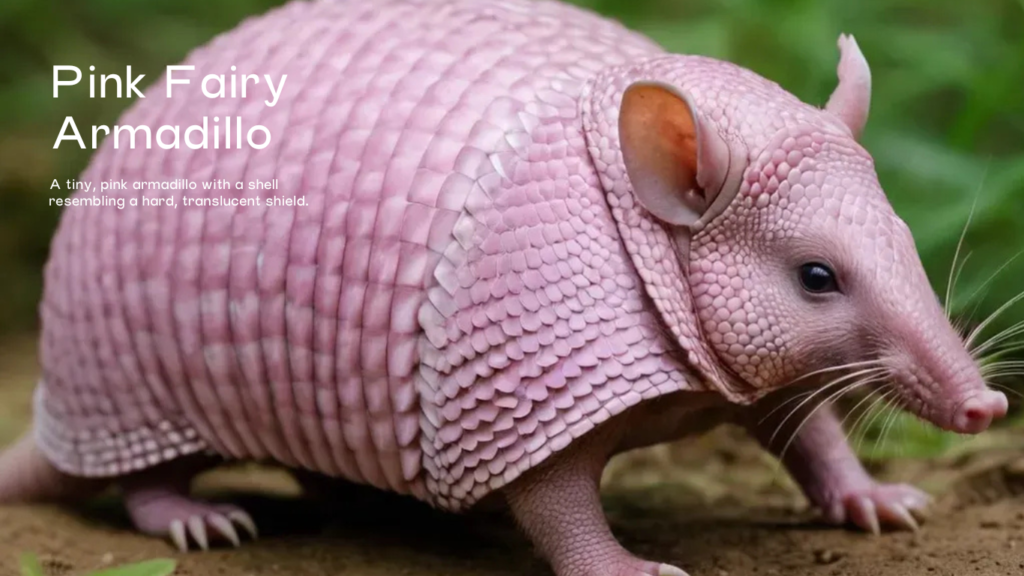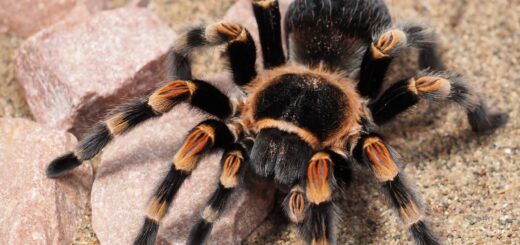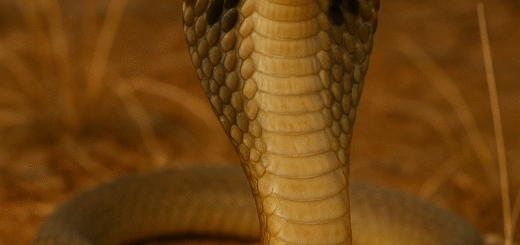The Pink Fairy Armadillo: Nature’s Tiny, Elusive Marvel
The Pink Fairy Armadillo (Chlamyphorus truncatus), often referred to as the “pichiciego” in its native Argentina, is one of the world’s most elusive and unique mammals. Known for its small size, delicate pink-colored shell, and secretive lifestyle, this little creature is both fascinating and mysterious. As the smallest member of the armadillo family, it has intrigued scientists, nature enthusiasts, and conservationists alike for decades.

Physical Description and Characteristics
The Pink Fairy Armadillo is remarkably small, typically measuring around 4 to 6 inches in length and weighing less than a quarter of a pound (about 120 grams). Its most distinguishing feature is its pink shell, which has a light, delicate appearance. Unlike the hard, round shells of larger armadillos, the Pink Fairy Armadillo’s shell is softer, flatter, and rectangular. This shell, more flexible than that of other armadillos, has a series of small, rib-like bands that protect the armadillo and allow it to burrow more efficiently.
The shell’s pink coloration, which results from blood vessels close to the surface, allows it to regulate body temperature. By expanding or contracting these blood vessels, the armadillo can dissipate or retain heat, making this shell a functional and adaptive feature. The armadillo’s fur is also light and soft, providing additional insulation in its underground burrow system.
Another notable feature is its large, clawed forelimbs, designed specifically for digging. These claws make it an effective digger, allowing it to burrow quickly and efficiently. The animal’s small eyes and limited eyesight suggest that vision is less important than other senses for survival, as it spends most of its time underground and relies heavily on touch and smell to navigate and find food.
Habitat and Distribution
Pink Fairy Armadillos are native to central Argentina, primarily inhabiting the sandy plains and scrubby grasslands of the region. This habitat, known as the Argentine Monte Desert, is characterized by a dry climate, sparse vegetation, and loose, sandy soil—ideal for the armadillo’s burrowing lifestyle. The armadillo spends most of its time underground, creating complex tunnel systems to navigate and find food. These tunnels provide a cool, humid environment, which is essential in a hot, arid landscape.
Because the Pink Fairy Armadillo is so elusive and difficult to study in its natural habitat, little is known about its specific range and population status. Their subterranean lifestyle and nocturnal habits further complicate efforts to study and conserve the species.
Diet and Feeding Behavior
As an insectivore, the Pink Fairy Armadillo primarily feeds on ants, termites, and other small invertebrates it encounters while burrowing. Its strong claws enable it to break into ant nests and termite mounds efficiently. The armadillo’s long, sticky tongue is perfectly adapted for catching and consuming these small creatures, much like an anteater.
In addition to ants and termites, Pink Fairy Armadillos may occasionally consume plant matter or roots, especially during times when insect prey is scarce. Because they have a fast metabolism, they need to eat frequently, which motivates them to stay on the move and dig through the soil in search of food.
Behavior and Lifestyle
The Pink Fairy Armadillo is nocturnal and highly reclusive, spending most of its life underground. By day, it typically remains hidden in its burrow to avoid the intense heat of the Argentine sun and the threat of predators. At night, it emerges to forage for food, using its keen sense of smell to locate insects and other small creatures in the soil.
This armadillo’s behavior is largely influenced by environmental conditions, particularly temperature and soil moisture. To maintain hydration, it often stays within its humid burrow system. In extremely dry periods, the armadillo may be more active above ground to find food and water sources. However, due to their secretive nature and the difficulty of studying them in the wild, scientists have only partial knowledge about their social behaviors and interactions.
Reproduction and Lifespan
Little is known about the reproductive habits of the Pink Fairy Armadillo, primarily because of its elusive behavior and difficulty of study in captivity. Generally, it is believed that armadillos in this species are solitary animals, coming together only during mating season. The female likely gives birth to a single offspring, as is common with small armadillos, and raises it in the safety of her burrow until it can survive on its own.
In captivity, the Pink Fairy Armadillo has a relatively short lifespan, often only a few years. However, their lifespan in the wild remains largely unknown, though it is thought to be slightly longer. Captive care is challenging, as the armadillos often suffer from stress, dietary issues, and the inability to replicate their natural habitat effectively, which limits the success of conservation efforts in artificial environments.
Conservation Status and Threats
The Pink Fairy Armadillo is listed as “Data Deficient” by the International Union for Conservation of Nature (IUCN), primarily because there is insufficient data about its population size, distribution, and trends. The armadillo’s elusive nature and underground lifestyle make it challenging to estimate its numbers and assess its conservation status accurately.
Several factors threaten the survival of the Pink Fairy Armadillo. Habitat loss due to agricultural expansion, particularly in central Argentina, poses a major risk to its survival. Pesticide use in agricultural areas can also affect their food sources, primarily insects. Climate change is another significant threat, as it can alter soil moisture levels and temperature, making it difficult for the armadillo to find suitable habitats.
Domestic animals, such as dogs and cats, pose additional dangers, as they may prey on armadillos or disturb their burrows. The species’ vulnerability to stress also complicates efforts to relocate or rehabilitate individuals, as they do not adapt well to captivity or environmental changes.
Conservation Efforts and Research
Efforts to protect the Pink Fairy Armadillo are hindered by a lack of data and limited funding. Conservationists emphasize the need for further research to understand the armadillo’s life cycle, behavior, and habitat requirements. Local awareness campaigns can help reduce threats from domestic animals and educate people about the importance of protecting this unique species.
One conservation approach involves working with local communities in Argentina to preserve the natural habitats of the Pink Fairy Armadillo. By protecting these sandy grasslands and desert areas, conservationists hope to provide a safer environment for the armadillo to thrive.
Given the armadillo’s vulnerability to environmental changes, scientists are also exploring potential climate change impacts on this species. Preserving suitable habitats and reducing habitat fragmentation are key priorities for ensuring the armadillo’s survival in the face of changing conditions.
Fascination with the Pink Fairy Armadillo
The Pink Fairy Armadillo continues to captivate scientists and nature enthusiasts alike with its unique appearance and secretive habits. Its pink, delicate shell, small size, and specialized burrowing lifestyle make it one of the most unusual animals in the world. For researchers, understanding the Pink Fairy Armadillo is an exciting but challenging task, as each discovery about this elusive creature provides new insights into the diversity and adaptability of life on Earth.
In popular culture, the Pink Fairy Armadillo has gained attention for its unusual and almost mythical appearance. Its unique appearance and rarity have even inspired efforts to raise awareness of other, lesser-known creatures that face similar conservation challenges. By highlighting the importance of biodiversity and habitat preservation, the Pink Fairy Armadillo serves as an ambassador for the unique wildlife of Argentina and the critical need to protect the planet’s most vulnerable species.
Conclusion
The Pink Fairy Armadillo is an extraordinary animal that reflects the diversity of the natural world and the importance of conservation. While much about this small, reclusive creature remains unknown, ongoing research and conservation efforts aim to protect its habitat and secure a future for this species. As one of the world’s smallest and most elusive armadillos, the Pink Fairy Armadillo continues to remind us of the wonders hidden beneath the surface and the resilience of life in challenging environments.








